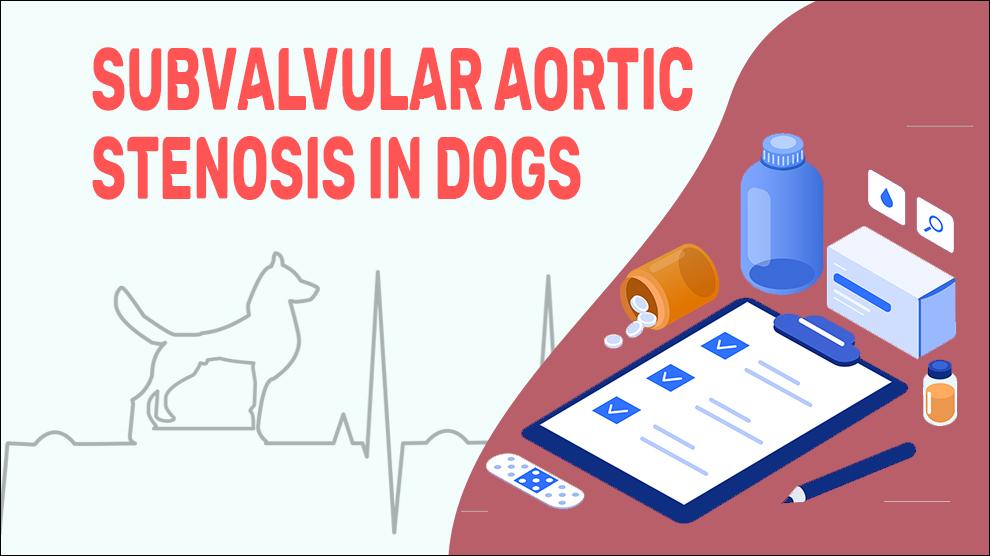What Is Subvalvular Aortic Stenosis In Dogs?
Subvalvular aortic stenosis (SAS) (subaortic stenosis) is an uncommon, non-inflammatory, progressive disease that affects the dog’s overall health and can cause problems in its daily life. Most commonly, it involves the occurrence of a distinct fibrous membrane (>75% of dogs) or the left ventricular outflow tract’s long tunnel-like muscular stenosis that is usually muscular just beneath the aortic valve. This causes a permanent hindrance to the flow of blood across the left ventricular outflow tract.
Although it is categorized as a congenital heart defect, important thing is that it is uncommon at birth and puppyhood, its progressive track and its postoperative recurrence suggest that it is, perhaps, an acquired condition.
Subvalvular aortic stenosis has a gamut of variants that occur in isolation or together with the others. The most common lesion is a slender discrete membrane. Other variants are a scattered fibromuscular tunnel-like contraction of the left ventricular outflow tract (LVOT), fibromuscular ridge, and anomalous or accessory mitral valve tissue.
SAS is associated with additional congenital heart defects that include patent ductus arteriosus, bicuspid aortic valve, ventricular septal defect, contraction of the aorta, atrioventricular septal defect, and atypical left ventricular papillary muscle, among others. Most commonly, SAS is found incidentally when examining dogs for other congenital heart defects.
Symptoms Of Subvalvular Aortic Stenosis In Dogs
- Abnormal pulses
- Difficulty breathing
- Loud heart murmur
- Stunted in growth
- Exercise intolerance
- Fatigue/ Cough
- Respiratory distress
- Fluid accumulation within the lungs (pulmonary edema) and abdomen (ascites)
Treatment Options For Subvalvular Aortic Stenosis In Dogs
Balloon valvuloplasty (valvotomy):
- This is a minimally-invasive nonsurgical procedure helpful when valves are thin, merged, and annular hypoplasia is not present.
- A small incision is made in the neck or groin region and a thin, flexible catheter will be inserted through the jugular vein and it is guided to the pulmonary valve.
- Fluoroscopy (live x-ray) is performed to determine the exact location and severity of the defect.
- At the site of the pulmonic valve, a balloon is positioned and it is used to inflate the area to make the blood flow freely and will be finally removed.
- The success rate of this procedure is good with recurrence also reported in a small percentage of cases.
Beta-blockers: Propranolol, Atenolol
Home Remedies For Subvalvular Aortic Stenosis In Dogs
- Once the surgery is over, activities of your dog should be restricted for about 2 weeks to allow recuperation and incision healing.
- A restrictive e-collar can be used for 2 weeks.
- Home-cooked diet, with wholesome, nutritious foods as a substitute for commercial diets.
How To Prevent Subvalvular Aortic Stenosis In Dogs?
The causes for SAS in dogs are varied so prevention is not possible. Treatment and survival rates vary depending on the type and severity of the defect.
Prevention of SAS is a hereditary concern. Dogs with SAS and that include first-degree relatives (parents and littermates) should be screened while breeding so as to avoid transmitting the condition to the next generation.
Affected Dog Breeds Of Subvalvular Aortic Stenosis
Bichon Frise, Large Dog Breeds, Giant Dog Breeds, Newfoundland, Golden Retriever, Boxer, Rottweiler, German Shepherd, English Bulldog, Great Dane, German Shorthaired Pointer, Bouvier Des Flandres, Dogue De Bordeaux, Bull Terrier, Mastiff, Samoyed
Causes And Prognosis For Subvalvular Aortic Stenosis In Dogs
1. Causes
- Mostly congenital
- Toxicological
- Malnutrition
- Environmental
- Infections
- Pharmaceuticals
2. Morbidity:
SAS is a very rare disorder seen in dogs (1 in 10,000 births) and with a male to female ratio of 2:1.
SAS causes clinically considerable blood flow obstruction casting out of the left ventricle leading to the concentric left ventricular hypertrophy development, often with a septal bulge. Consequently, this results in the additional impediment and hyperdynamic function.
In isolated SAS, systolic function and cardiac output are maintained well until the development of severe obstruction.
SAS rate of progression is uneven and unpredictable in puppies, while in adults, its progression is slow.
3. Mortality:
The untreated SAS manifests clinical signs typically within a year. If left untreated, Dogs with SAS have a more than 50% mortality rate by one year of age.
4. Diagnosis:
- Routine hematology, urinalysis
- Serum chemistry profile
- Cardiac ultrasound
- Electrocardiogram
- Echocardiography
5. Prognosis:
When diagnosed early and provided prompt treatment with successful closure of the SAS, most dogs have a comfortable life. After surgery, further medications are required only if there are complications from previously developed heart conditions, otherwise, there are hardly any medications required in the future.
When To See A Vet For Subvalvular Aortic Stenosis In Dogs?
Contact your vet right away, if you notice any of the following:
- Abnormal pulses
- Difficulty breathing
- Loud heart murmur
Food Suggestions For Subvalvular Aortic Stenosis In Dogs
- High protein diet with complex carbs and good fats
- Protein should comprise 40% of dogs’ calories, and at least 30% meat-based protein (on a dry matter basis) is recommended
- Fresh, lean protein (Lean white fish such as cod, grouper, haddock, lean cuts of beef, pork loin)
- Fats: Salmon, herring, mackerel, lake trout, tuna, and sardines
- Complex Carbs: Brown Rice, Oatmeal, Whole Grains, Sweet Potatoes, etc
- Vitamin-rich fruits and veggies: Legumes, snap peas, green beans, carrots, cauliflower, broccoli, cabbage, tomatoes, citrus fruits, Blueberries, strawberries, cherries, etc
Conclusion
The prognosis for SAS in dogs depends on the extent of damage and the overall health of the pet.
Early detection and suitable treatment offer the most favorable prognosis. In general, dogs that have a surgical repair for SAS survival rate is good.

















